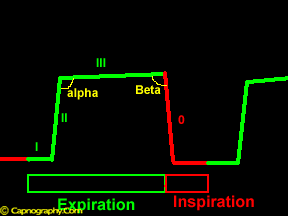When it comes to the health and safety of our patients, every detail matters. One of the most critical tools in ensuring a smooth and safe surgical experience is capnography. But what exactly is capnography, and why is it such a game-changer in veterinary anaesthesia? Let’s explore the fascinating world of capnography and its pivotal role in advanced anaesthesia for veterinary nurses.
What Is Capnography?
Capnography is the monitoring of the concentration or partial pressure of carbon dioxide (CO2) in respiratory gases. In simpler terms, it’s a way for us to keep a close eye on how well an animal is breathing during anaesthesia. This is done by measuring the CO2 levels in the breath that the animal exhales.
Normal Capnography

Phase One
This is normally a flat baseline segment of the capnogram. This is the first part of the phase when inspiration occurs
Phase Two
Phase two is the upstroke of the waveform. This corresponds to the part of exhalation where CO2 containing alveolar gas starts to be exhaled in a mizture with gas from the anatomical dead space. As expiration continues, the expired gas is made up of rapidly increasing levels of alveolar gas and CO2 levels begin to rise.
Phase Three
This phase show the plateau of the capnogram. At this point, PCO2 is normally almost constant as alveolar gas is exhaled. Expiration ends through this phase and is normally followed by a pause.
During this pause, PCO2 remains constant, eventhohgh there is no gas flowing in or out of the patient. This is due to, aleveolar expired gas remaining still within the breathing circuit.
This part of the plateau can be cut short by small tidal volumes, high fresh gas flow rate or high gas sampling rates.
Phase Four
This is the rapid downstroke shown on the capnogram which corresponds with inspiration. During Phase Four, fresh inspired gas passess through the sampling port as it moves to the lungs.
The Superpowers Of Capnography
Capnography is like a superpower for the anaesthesia based RVN, offering real-time insights and ensuring that everything is going smoothly during surgery. Here’s why capnography is an essential tool in veterinary anaesthesia:
Guarding Against Respiratory Complications
One of the most critical roles of capnography is monitoring the animal’s ventilation. It provides a continuous, display of the respiratory rate and pattern. If an animal stops breathing (apnoea) or starts breathing irregularly (dyspnoea, hyperventilation, hypoventilation), capnography will alert us immediately, allowing for quick intervention.
Spotting Airway Obstructions
Capnography can detect partial or complete airway obstructions. If there’s any blockage in the airway, the CO2 levels in the exhaled breath will change, triggering us to take action
Monitoring Cardiovascular Health
Capnography doesn’t just keep an eye on the lungs—it also offers valuable insights into the patients cardiovascular status. Sudden drops in CO2 levels can indicate issues like decreased cardiac output or even cardiac arrest. It’s like having a window into the heart’s performance during anaesthesia.
Ensuring Adequate Anaesthesia Depth
Too deep of a plane of anaesthesia can lead to respiratory depression, while too little can result in the animal waking up during surgery. Capnography helps in maintaining the perfect balance by providing data on the animal’s ventilation status, ensuring they are on the correct plane of anaesthesia.
Quickly Detecting Equipment Failures
If there’s a disconnect in the circuit system or a leak, capnography will show abnormal CO2 levels, alerting the veterinary team to check the equipment immediately. This helps prevent any potential mishaps during the procedure.
Aiding in Postoperative Recovery
After surgery, capnography continues to be useful by monitoring the animal’s recovery. It ensures that the pet is breathing well on their own before they are fully awake and ready to go home.
Fun Fact: Capnography is Non-Invasive!
One of the great things about capnography is that it’s a non-invasive procedure. It continuously monitors the animal’s breathing without needing blood samples or other invasive measures. This makes anaesthesia for Veterinary Nurses and Vets much safer and allows us to obtain vital information to make correct decisions and interventions.
The Bottom Line
Capnography is an indispensable tool in veterinary anaesthesia, offering unparalleled monitoring of an animal’s respiratory and cardiovascular health. It helps us catch potential issues early, ensuring we put into place are interventions and adjust anaesthesia as and when required. Capnography is for me, the most important piece of equipment and should be something we look at and assess when monitoring our patients.
Want To Know More?
Would you like to know more about anaesthesia? If so we offer in-house CPD training for you and your team! Take a look at our anaesthesia in-house CPD here

